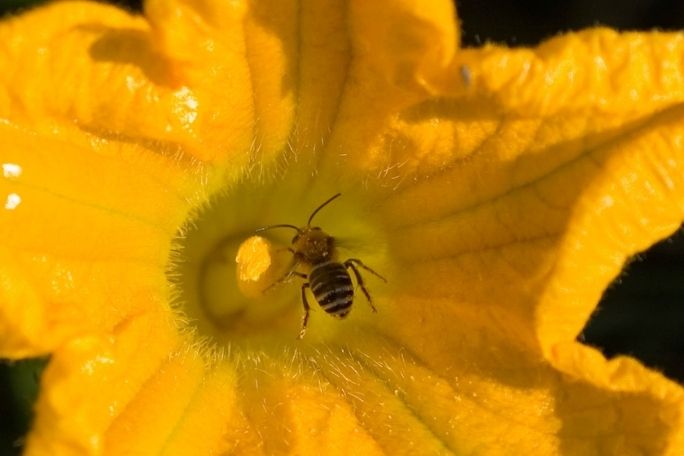Lesson summary
Bees pollinate at least a third of everything we eat and play a vital role in sustaining our ecosystems, therefore they need to be valued and protected. In this lesson, students will dissect a flower to examine the internal anatomy that assists with attracting pollinators to aid in reproduction. They will then explore the body structure of bees that assist with the pollination process. Finally, students explore the symbiotic relationship that exists between bees and flowering plants and the adaptations which allow this relationship to be mutually beneficial.
Essential questions:
- What adaptations do flowers have to assist with pollination?
- What adaptations do bees have to assist with pollination?
- What is the relationships between bees, flowering plants and food?
Lesson guides and printables
Lesson details
Curriculum mapping
Australian curriculum content descriptions:
Year 5 Science:
- Living things have structural features and adaptations that help them to survive in their environment (ACSSU043)
- With guidance, pose clarifying questions and make predictions about scientific investigations (ACSIS231)
- Communicate ideas, explanations and processes using scientific representations in a variety of ways, including multi-modal texts (ACSIS093)
Year 5 English:
- Clarify understanding of content as it unfolds in formal and informal situations, connecting ideas to students’ own experiences and present and justify a point of view (ACELY1699)
- Use comprehension strategies to analyse information, integrating and linking ideas from a variety of print and digital sources (ACELY1703)
Year 6 Science:
- The growth and survival of living things are affected by physical conditions of their environment (ACSSU094)
- With guidance, pose clarifying questions and make predictions about scientific investigations (ACSIS232)
- Communicate ideas, explanations and processes using scientific representations in a variety of ways, including multi-modal texts (ACSIS110)
Year 6 English:
- Use comprehension strategies to interpret and analyse information and ideas, comparing content from a variety of textual sources including media and digital texts (AACELY1713)
General capabilities: Critical and Creative Thinking, Personal and Social Capability
Cross-curriculum priority: Sustainability OI.1, OI.2, OI.3
Relevant parts of Year 5 English achievement standards: When reading, students encounter and decode unfamiliar words using phonic, grammatical, semantic and contextual knowledge. They listen and ask questions to clarify content. They contribute actively to class and group discussions, taking into account other perspectives.
Relevant parts of Year 5 Science achievement standards: Analyse how the form of living things enables them to function in their environments.
Relevant parts of Year 6 English achievement standards: Students select and use evidence from a text to explain their response to it. They listen to discussions, clarifying content and challenging others’ ideas. They make presentations and contribute actively to class and group discussions, using a variety of strategies for effect.
Relevant parts of Year 6 Science achievement standards: Describe and predict the effect of environmental changes on individual living things.
Unit of work: Love Food? Love Bees!
Time required: 90 mins.
Level of teacher scaffolding: High – facilitate class discussion.
Resources required
- Student Worksheet and Adaptations – Bee and Plant Factsheet – one printed copy per student
- Projector, butcher’s paper, scissors, tweezers, collection of flowers for dissection (1-2 flowers per group), workbooks or piece of A4 sized paper for each student, grey lead pencils and magnifying glasses (if available), sticky-notes
- Hive of Reflection print-out
Skills
This lesson is designed to build students’ competencies in the following skills:
- Communication
- Critical thinking
- Collaboration
- Ethical understanding
- Social skills
Additional info
This lesson has been created in partnership with ACT for Bees. ACT for Bees is a not-for-profit organisation taking action to preserve these essential pollinators, ensuring a food-secure future.


Welcome back!
Don't have an account yet?
Log in with:
By signing up to Cool.org you consent and agree to Cool's privacy policy to
store, manage and process your personal information. To read more, please see
our privacy policy here(Opens in new tab).
Create your free Cool.org account.
Many of our resources are free, with an option to upgrade to Cool+ for premium content.
Already have an account?
Sign up with:
By signing up to Cool.org you consent and agree to Cool's privacy policy to
store, manage and process your personal information. To read more, please see
our privacy policy here(Opens in new tab).